A Statistical Report: Variation in Tobacco Use Across Gender
VerifiedAdded on 2021/04/16
|11
|1543
|26
Report
AI Summary
This report, authored by a student, examines the variation in tobacco use across gender, focusing on data from the Youth Tobacco Survey. The study employs descriptive statistics, including mean, median, mode, and standard deviation, to analyze the consumption patterns of male and female frequent tobacco users. Data analysis reveals the average percentage of male frequent tobacco users to be 2.175, while for females it is 1.47. The report further utilizes variability tests and t-tests to determine if there are significant differences in smoking rates between genders. The t-test results, with a p-value of 0.165, suggest no significant differences, leading to the acceptance of the null hypothesis. The conclusion highlights that both genders exhibit similar percentages of frequent smokers, emphasizing the need for further analysis of long-term trends and additional factors influencing tobacco consumption.
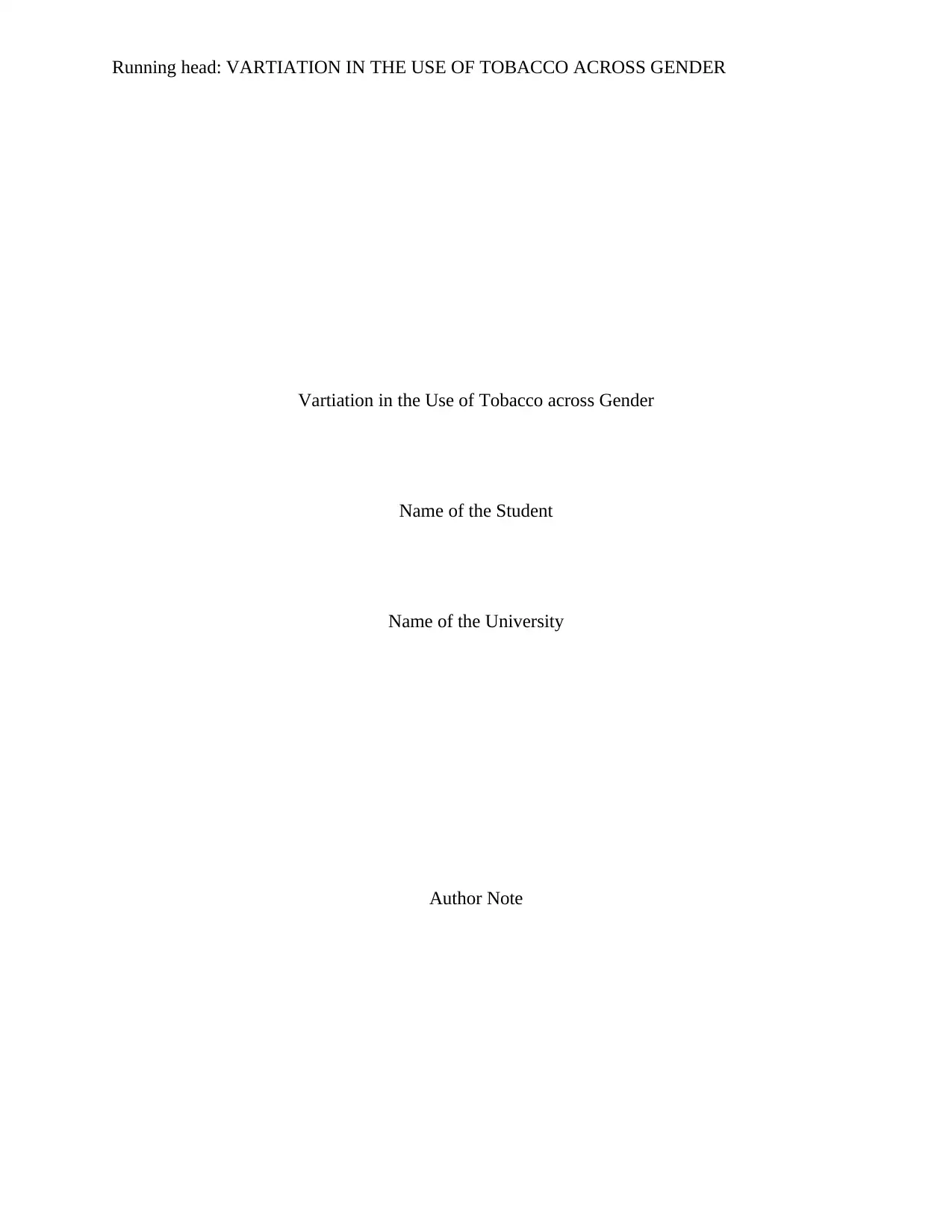
Running head: VARTIATION IN THE USE OF TOBACCO ACROSS GENDER
Vartiation in the Use of Tobacco across Gender
Name of the Student
Name of the University
Author Note
Vartiation in the Use of Tobacco across Gender
Name of the Student
Name of the University
Author Note
Paraphrase This Document
Need a fresh take? Get an instant paraphrase of this document with our AI Paraphraser
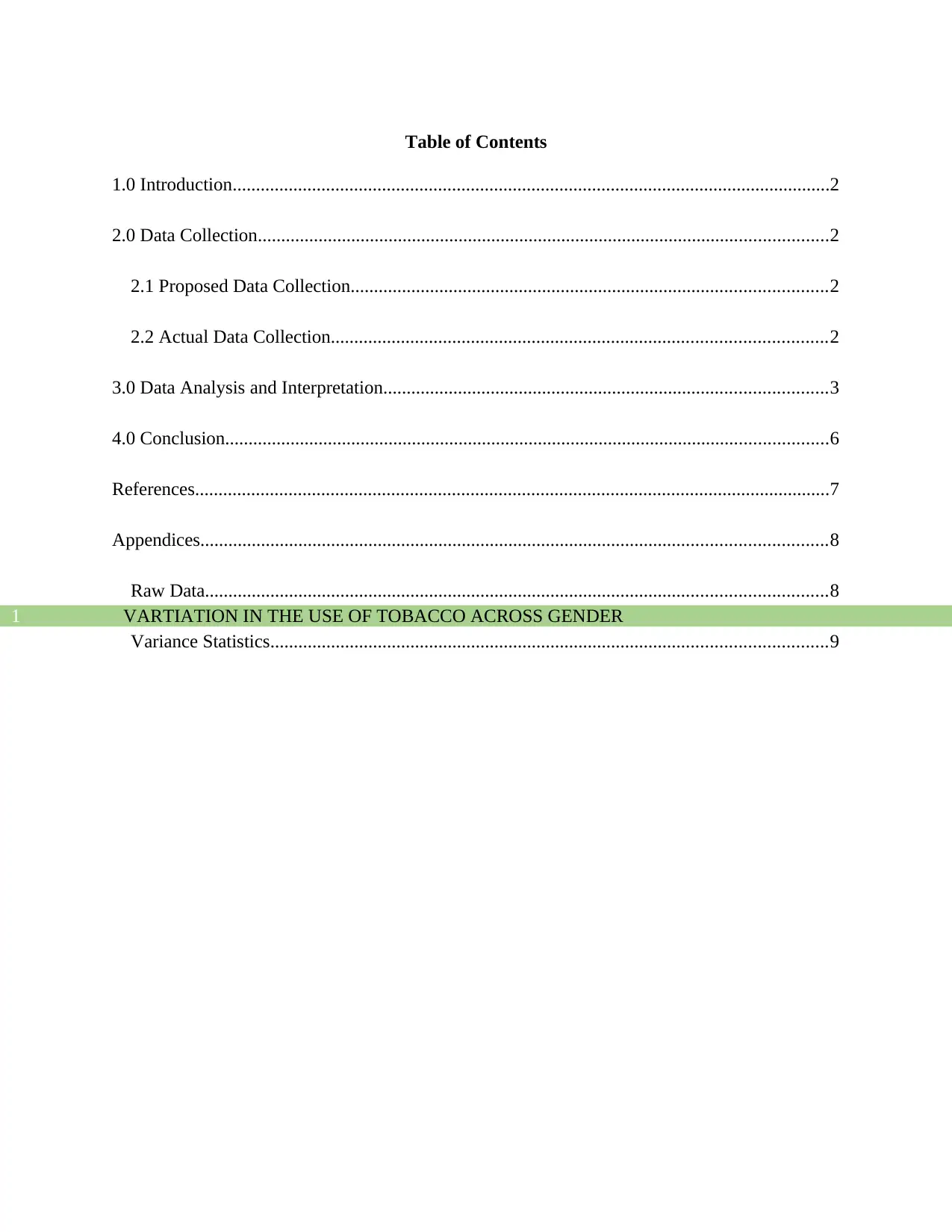
VARTIATION IN THE USE OF TOBACCO ACROSS GENDER1
Table of Contents
1.0 Introduction................................................................................................................................2
2.0 Data Collection..........................................................................................................................2
2.1 Proposed Data Collection......................................................................................................2
2.2 Actual Data Collection..........................................................................................................2
3.0 Data Analysis and Interpretation...............................................................................................3
4.0 Conclusion.................................................................................................................................6
References........................................................................................................................................7
Appendices......................................................................................................................................8
Raw Data.....................................................................................................................................8
Variance Statistics.......................................................................................................................9
Table of Contents
1.0 Introduction................................................................................................................................2
2.0 Data Collection..........................................................................................................................2
2.1 Proposed Data Collection......................................................................................................2
2.2 Actual Data Collection..........................................................................................................2
3.0 Data Analysis and Interpretation...............................................................................................3
4.0 Conclusion.................................................................................................................................6
References........................................................................................................................................7
Appendices......................................................................................................................................8
Raw Data.....................................................................................................................................8
Variance Statistics.......................................................................................................................9
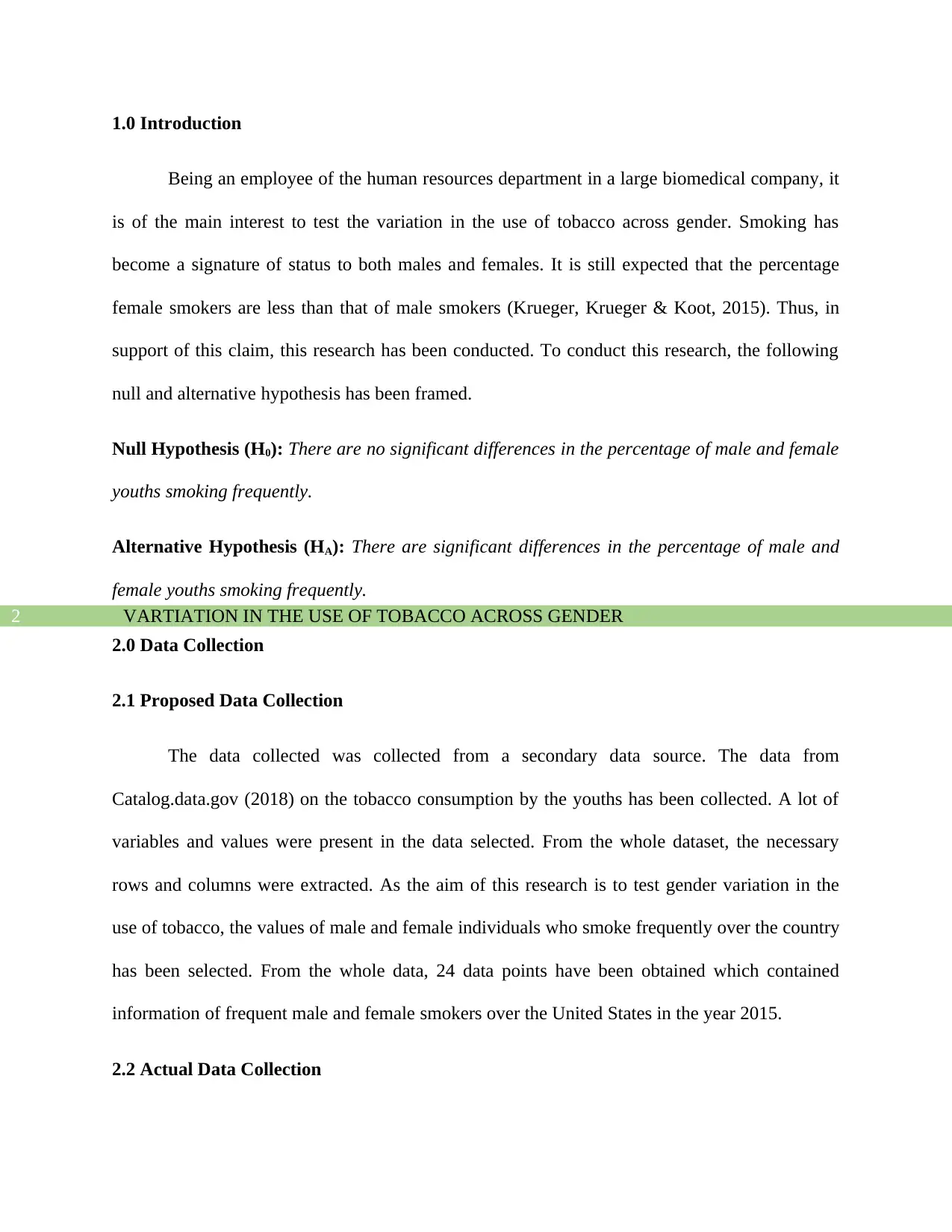
VARTIATION IN THE USE OF TOBACCO ACROSS GENDER2
1.0 Introduction
Being an employee of the human resources department in a large biomedical company, it
is of the main interest to test the variation in the use of tobacco across gender. Smoking has
become a signature of status to both males and females. It is still expected that the percentage
female smokers are less than that of male smokers (Krueger, Krueger & Koot, 2015). Thus, in
support of this claim, this research has been conducted. To conduct this research, the following
null and alternative hypothesis has been framed.
Null Hypothesis (H0): There are no significant differences in the percentage of male and female
youths smoking frequently.
Alternative Hypothesis (HA): There are significant differences in the percentage of male and
female youths smoking frequently.
2.0 Data Collection
2.1 Proposed Data Collection
The data collected was collected from a secondary data source. The data from
Catalog.data.gov (2018) on the tobacco consumption by the youths has been collected. A lot of
variables and values were present in the data selected. From the whole dataset, the necessary
rows and columns were extracted. As the aim of this research is to test gender variation in the
use of tobacco, the values of male and female individuals who smoke frequently over the country
has been selected. From the whole data, 24 data points have been obtained which contained
information of frequent male and female smokers over the United States in the year 2015.
2.2 Actual Data Collection
1.0 Introduction
Being an employee of the human resources department in a large biomedical company, it
is of the main interest to test the variation in the use of tobacco across gender. Smoking has
become a signature of status to both males and females. It is still expected that the percentage
female smokers are less than that of male smokers (Krueger, Krueger & Koot, 2015). Thus, in
support of this claim, this research has been conducted. To conduct this research, the following
null and alternative hypothesis has been framed.
Null Hypothesis (H0): There are no significant differences in the percentage of male and female
youths smoking frequently.
Alternative Hypothesis (HA): There are significant differences in the percentage of male and
female youths smoking frequently.
2.0 Data Collection
2.1 Proposed Data Collection
The data collected was collected from a secondary data source. The data from
Catalog.data.gov (2018) on the tobacco consumption by the youths has been collected. A lot of
variables and values were present in the data selected. From the whole dataset, the necessary
rows and columns were extracted. As the aim of this research is to test gender variation in the
use of tobacco, the values of male and female individuals who smoke frequently over the country
has been selected. From the whole data, 24 data points have been obtained which contained
information of frequent male and female smokers over the United States in the year 2015.
2.2 Actual Data Collection
⊘ This is a preview!⊘
Do you want full access?
Subscribe today to unlock all pages.

Trusted by 1+ million students worldwide
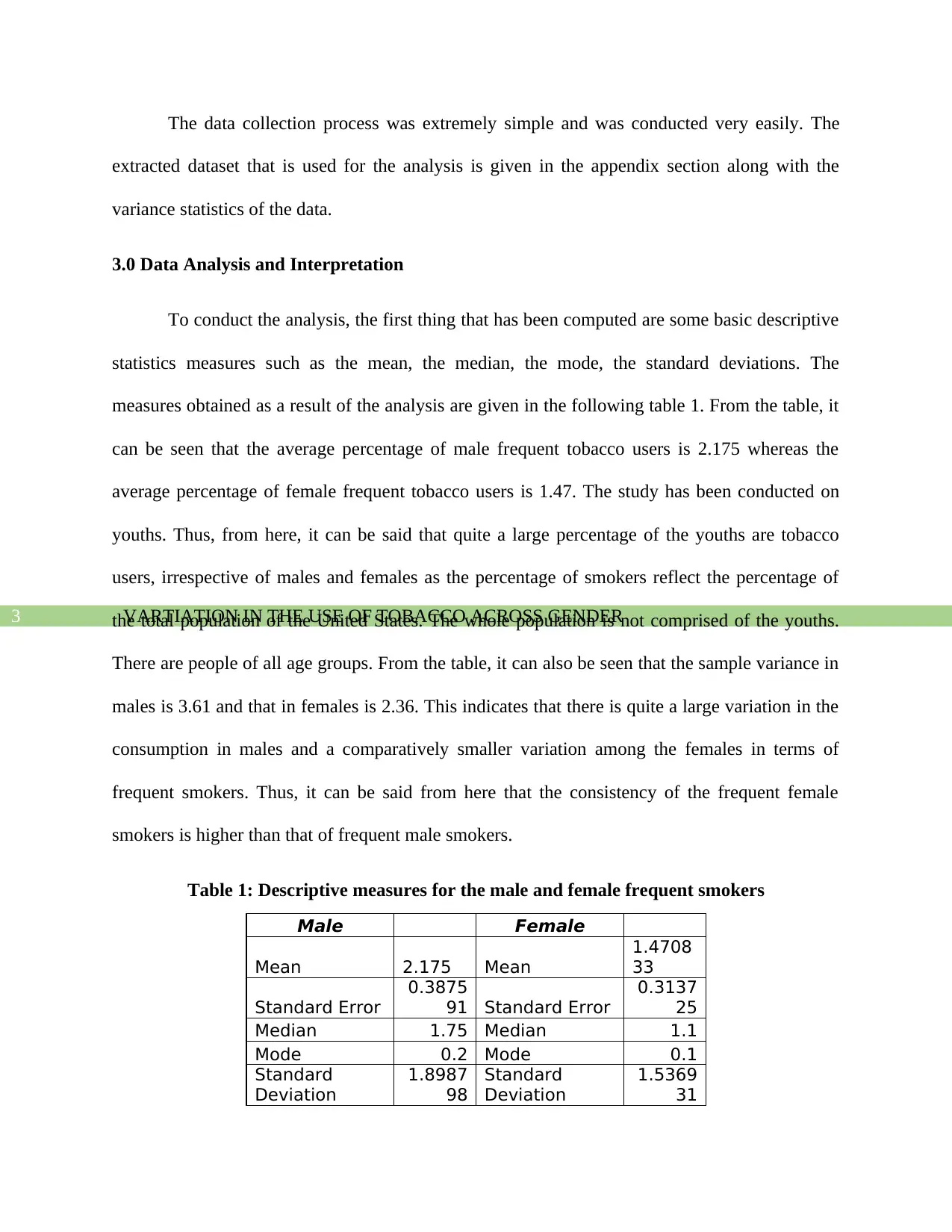
VARTIATION IN THE USE OF TOBACCO ACROSS GENDER3
The data collection process was extremely simple and was conducted very easily. The
extracted dataset that is used for the analysis is given in the appendix section along with the
variance statistics of the data.
3.0 Data Analysis and Interpretation
To conduct the analysis, the first thing that has been computed are some basic descriptive
statistics measures such as the mean, the median, the mode, the standard deviations. The
measures obtained as a result of the analysis are given in the following table 1. From the table, it
can be seen that the average percentage of male frequent tobacco users is 2.175 whereas the
average percentage of female frequent tobacco users is 1.47. The study has been conducted on
youths. Thus, from here, it can be said that quite a large percentage of the youths are tobacco
users, irrespective of males and females as the percentage of smokers reflect the percentage of
the total population of the United States. The whole population is not comprised of the youths.
There are people of all age groups. From the table, it can also be seen that the sample variance in
males is 3.61 and that in females is 2.36. This indicates that there is quite a large variation in the
consumption in males and a comparatively smaller variation among the females in terms of
frequent smokers. Thus, it can be said from here that the consistency of the frequent female
smokers is higher than that of frequent male smokers.
Table 1: Descriptive measures for the male and female frequent smokers
Male Female
Mean 2.175 Mean
1.4708
33
Standard Error
0.3875
91 Standard Error
0.3137
25
Median 1.75 Median 1.1
Mode 0.2 Mode 0.1
Standard
Deviation
1.8987
98
Standard
Deviation
1.5369
31
The data collection process was extremely simple and was conducted very easily. The
extracted dataset that is used for the analysis is given in the appendix section along with the
variance statistics of the data.
3.0 Data Analysis and Interpretation
To conduct the analysis, the first thing that has been computed are some basic descriptive
statistics measures such as the mean, the median, the mode, the standard deviations. The
measures obtained as a result of the analysis are given in the following table 1. From the table, it
can be seen that the average percentage of male frequent tobacco users is 2.175 whereas the
average percentage of female frequent tobacco users is 1.47. The study has been conducted on
youths. Thus, from here, it can be said that quite a large percentage of the youths are tobacco
users, irrespective of males and females as the percentage of smokers reflect the percentage of
the total population of the United States. The whole population is not comprised of the youths.
There are people of all age groups. From the table, it can also be seen that the sample variance in
males is 3.61 and that in females is 2.36. This indicates that there is quite a large variation in the
consumption in males and a comparatively smaller variation among the females in terms of
frequent smokers. Thus, it can be said from here that the consistency of the frequent female
smokers is higher than that of frequent male smokers.
Table 1: Descriptive measures for the male and female frequent smokers
Male Female
Mean 2.175 Mean
1.4708
33
Standard Error
0.3875
91 Standard Error
0.3137
25
Median 1.75 Median 1.1
Mode 0.2 Mode 0.1
Standard
Deviation
1.8987
98
Standard
Deviation
1.5369
31
Paraphrase This Document
Need a fresh take? Get an instant paraphrase of this document with our AI Paraphraser

VARTIATION IN THE USE OF TOBACCO ACROSS GENDER4
Sample
Variance
3.6054
35
Sample
Variance
2.3621
56
Kurtosis
-
0.7868
5 Kurtosis
-
0.1966
Skewness
0.5632
1 Skewness
0.9262
5
Range 6.3 Range 5.2
Minimum 0 Minimum 0
Maximum 6.3 Maximum 5.2
Sum 52.2 Sum 35.3
Count 24 Count 24
Source: As created by Author
Apart from the descriptive analysis conducted above, there is another important tool that
can be used to draw a conclusion about the data. This is known as the variability test. The mean
and the variance discussed in the part earlier is affected by the presence of any extreme values.
Thus, a more standardized measure has been computed to test the variability of the data. This is
known as the variability test. From the mean scores, it was not possible to obtain the actual clear
picture of the percentage of youth that smoke in different states of the country. Thus, it was not
possible to understand whether the null hypothesis proposed earlier will be accepted or rejected.
Thus, from the figure given below, figure 1 shows that the data is almost normal. It can also be
seen that value of skewness obtained from table 1 is close to zero. Thus, the data can be
considered as symmetric. Similarly, from figure 2, it can also be seen that the data is
symmetrically distributed.
Sample
Variance
3.6054
35
Sample
Variance
2.3621
56
Kurtosis
-
0.7868
5 Kurtosis
-
0.1966
Skewness
0.5632
1 Skewness
0.9262
5
Range 6.3 Range 5.2
Minimum 0 Minimum 0
Maximum 6.3 Maximum 5.2
Sum 52.2 Sum 35.3
Count 24 Count 24
Source: As created by Author
Apart from the descriptive analysis conducted above, there is another important tool that
can be used to draw a conclusion about the data. This is known as the variability test. The mean
and the variance discussed in the part earlier is affected by the presence of any extreme values.
Thus, a more standardized measure has been computed to test the variability of the data. This is
known as the variability test. From the mean scores, it was not possible to obtain the actual clear
picture of the percentage of youth that smoke in different states of the country. Thus, it was not
possible to understand whether the null hypothesis proposed earlier will be accepted or rejected.
Thus, from the figure given below, figure 1 shows that the data is almost normal. It can also be
seen that value of skewness obtained from table 1 is close to zero. Thus, the data can be
considered as symmetric. Similarly, from figure 2, it can also be seen that the data is
symmetrically distributed.
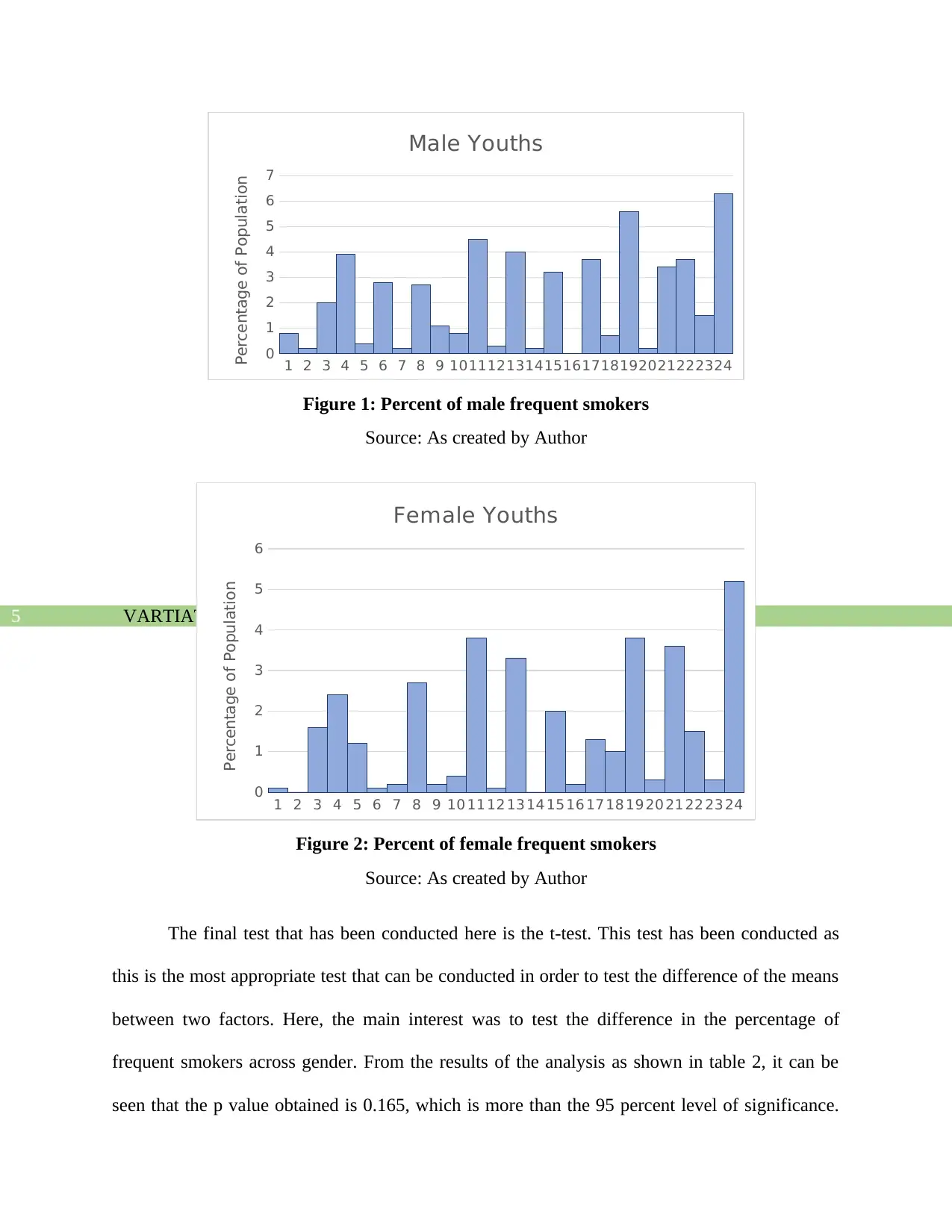
VARTIATION IN THE USE OF TOBACCO ACROSS GENDER5
1 2 3 4 5 6 7 8 9 101112131415161718192021222324
0
1
2
3
4
5
6
7
Male Youths
Percentage of Population
Figure 1: Percent of male frequent smokers
Source: As created by Author
1 2 3 4 5 6 7 8 9 10 11 12 13 14 15 16 17 18 19 20 21 22 23 24
0
1
2
3
4
5
6
Female Youths
Percentage of Population
Figure 2: Percent of female frequent smokers
Source: As created by Author
The final test that has been conducted here is the t-test. This test has been conducted as
this is the most appropriate test that can be conducted in order to test the difference of the means
between two factors. Here, the main interest was to test the difference in the percentage of
frequent smokers across gender. From the results of the analysis as shown in table 2, it can be
seen that the p value obtained is 0.165, which is more than the 95 percent level of significance.
1 2 3 4 5 6 7 8 9 101112131415161718192021222324
0
1
2
3
4
5
6
7
Male Youths
Percentage of Population
Figure 1: Percent of male frequent smokers
Source: As created by Author
1 2 3 4 5 6 7 8 9 10 11 12 13 14 15 16 17 18 19 20 21 22 23 24
0
1
2
3
4
5
6
Female Youths
Percentage of Population
Figure 2: Percent of female frequent smokers
Source: As created by Author
The final test that has been conducted here is the t-test. This test has been conducted as
this is the most appropriate test that can be conducted in order to test the difference of the means
between two factors. Here, the main interest was to test the difference in the percentage of
frequent smokers across gender. From the results of the analysis as shown in table 2, it can be
seen that the p value obtained is 0.165, which is more than the 95 percent level of significance.
⊘ This is a preview!⊘
Do you want full access?
Subscribe today to unlock all pages.

Trusted by 1+ million students worldwide
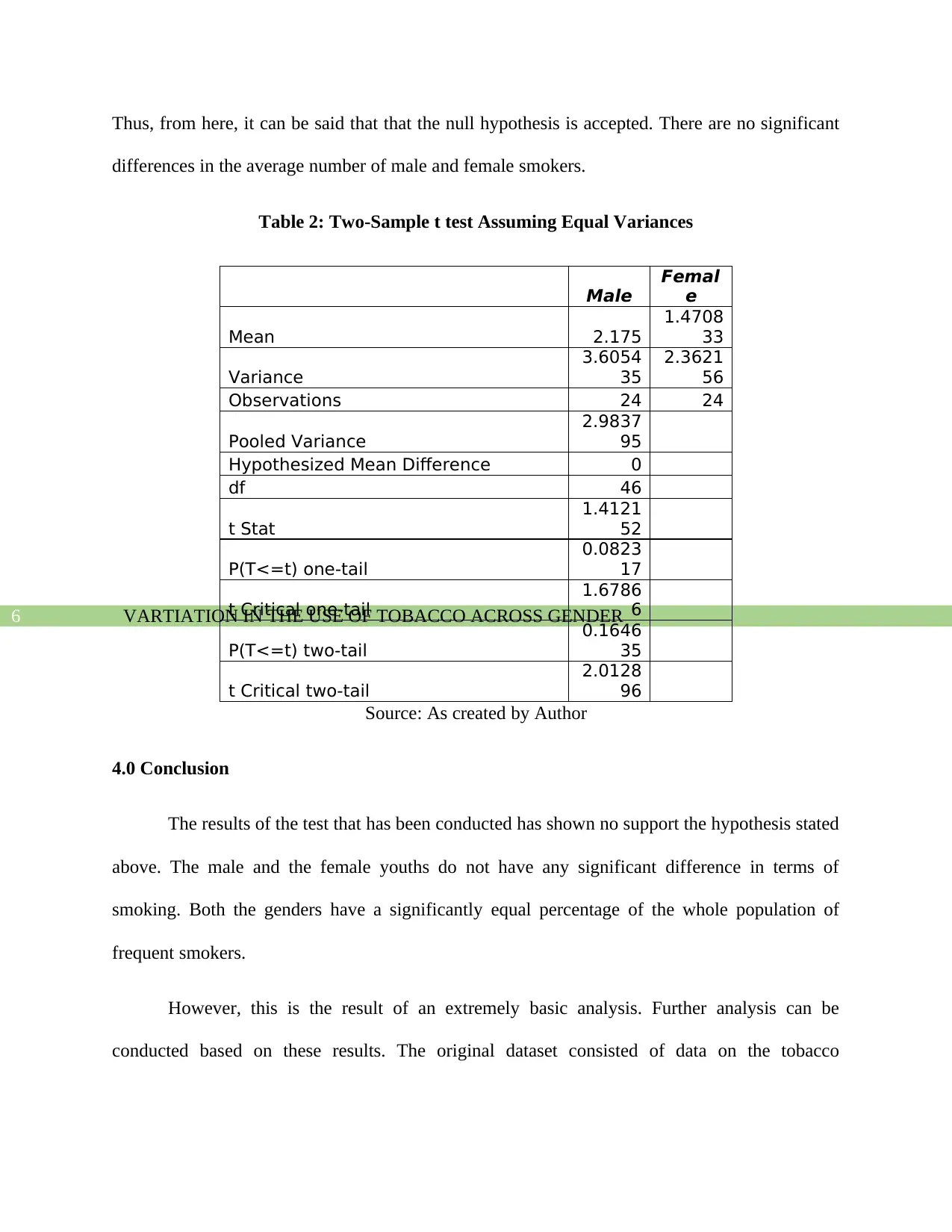
VARTIATION IN THE USE OF TOBACCO ACROSS GENDER6
Thus, from here, it can be said that that the null hypothesis is accepted. There are no significant
differences in the average number of male and female smokers.
Table 2: Two-Sample t test Assuming Equal Variances
Male
Femal
e
Mean 2.175
1.4708
33
Variance
3.6054
35
2.3621
56
Observations 24 24
Pooled Variance
2.9837
95
Hypothesized Mean Difference 0
df 46
t Stat
1.4121
52
P(T<=t) one-tail
0.0823
17
t Critical one-tail
1.6786
6
P(T<=t) two-tail
0.1646
35
t Critical two-tail
2.0128
96
Source: As created by Author
4.0 Conclusion
The results of the test that has been conducted has shown no support the hypothesis stated
above. The male and the female youths do not have any significant difference in terms of
smoking. Both the genders have a significantly equal percentage of the whole population of
frequent smokers.
However, this is the result of an extremely basic analysis. Further analysis can be
conducted based on these results. The original dataset consisted of data on the tobacco
Thus, from here, it can be said that that the null hypothesis is accepted. There are no significant
differences in the average number of male and female smokers.
Table 2: Two-Sample t test Assuming Equal Variances
Male
Femal
e
Mean 2.175
1.4708
33
Variance
3.6054
35
2.3621
56
Observations 24 24
Pooled Variance
2.9837
95
Hypothesized Mean Difference 0
df 46
t Stat
1.4121
52
P(T<=t) one-tail
0.0823
17
t Critical one-tail
1.6786
6
P(T<=t) two-tail
0.1646
35
t Critical two-tail
2.0128
96
Source: As created by Author
4.0 Conclusion
The results of the test that has been conducted has shown no support the hypothesis stated
above. The male and the female youths do not have any significant difference in terms of
smoking. Both the genders have a significantly equal percentage of the whole population of
frequent smokers.
However, this is the result of an extremely basic analysis. Further analysis can be
conducted based on these results. The original dataset consisted of data on the tobacco
Paraphrase This Document
Need a fresh take? Get an instant paraphrase of this document with our AI Paraphraser

VARTIATION IN THE USE OF TOBACCO ACROSS GENDER7
consumption from 1999 to 2015. Thus, the increase or decrease in the percentage of females and
male smokers can also be tested.
consumption from 1999 to 2015. Thus, the increase or decrease in the percentage of females and
male smokers can also be tested.
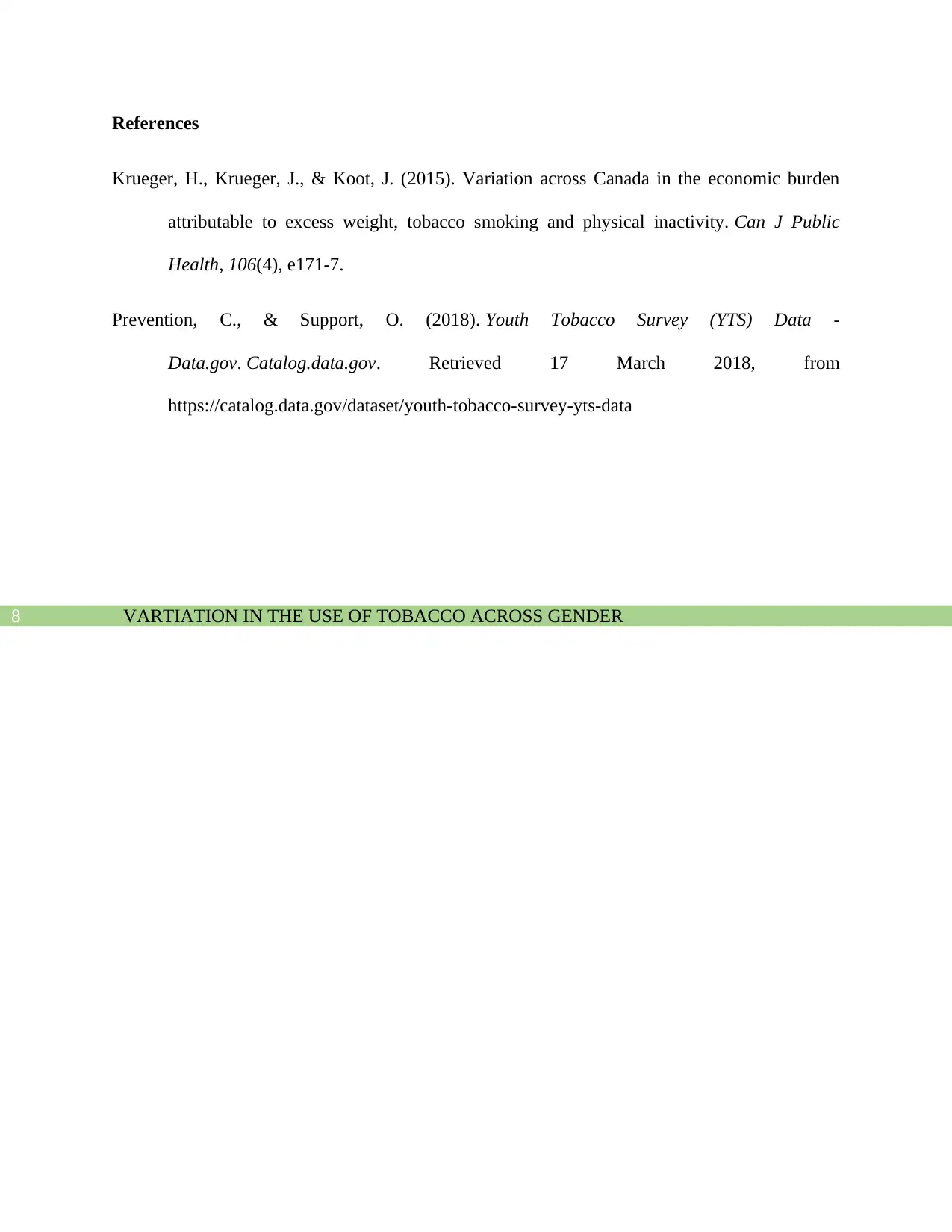
VARTIATION IN THE USE OF TOBACCO ACROSS GENDER8
References
Krueger, H., Krueger, J., & Koot, J. (2015). Variation across Canada in the economic burden
attributable to excess weight, tobacco smoking and physical inactivity. Can J Public
Health, 106(4), e171-7.
Prevention, C., & Support, O. (2018). Youth Tobacco Survey (YTS) Data -
Data.gov. Catalog.data.gov. Retrieved 17 March 2018, from
https://catalog.data.gov/dataset/youth-tobacco-survey-yts-data
References
Krueger, H., Krueger, J., & Koot, J. (2015). Variation across Canada in the economic burden
attributable to excess weight, tobacco smoking and physical inactivity. Can J Public
Health, 106(4), e171-7.
Prevention, C., & Support, O. (2018). Youth Tobacco Survey (YTS) Data -
Data.gov. Catalog.data.gov. Retrieved 17 March 2018, from
https://catalog.data.gov/dataset/youth-tobacco-survey-yts-data
⊘ This is a preview!⊘
Do you want full access?
Subscribe today to unlock all pages.

Trusted by 1+ million students worldwide
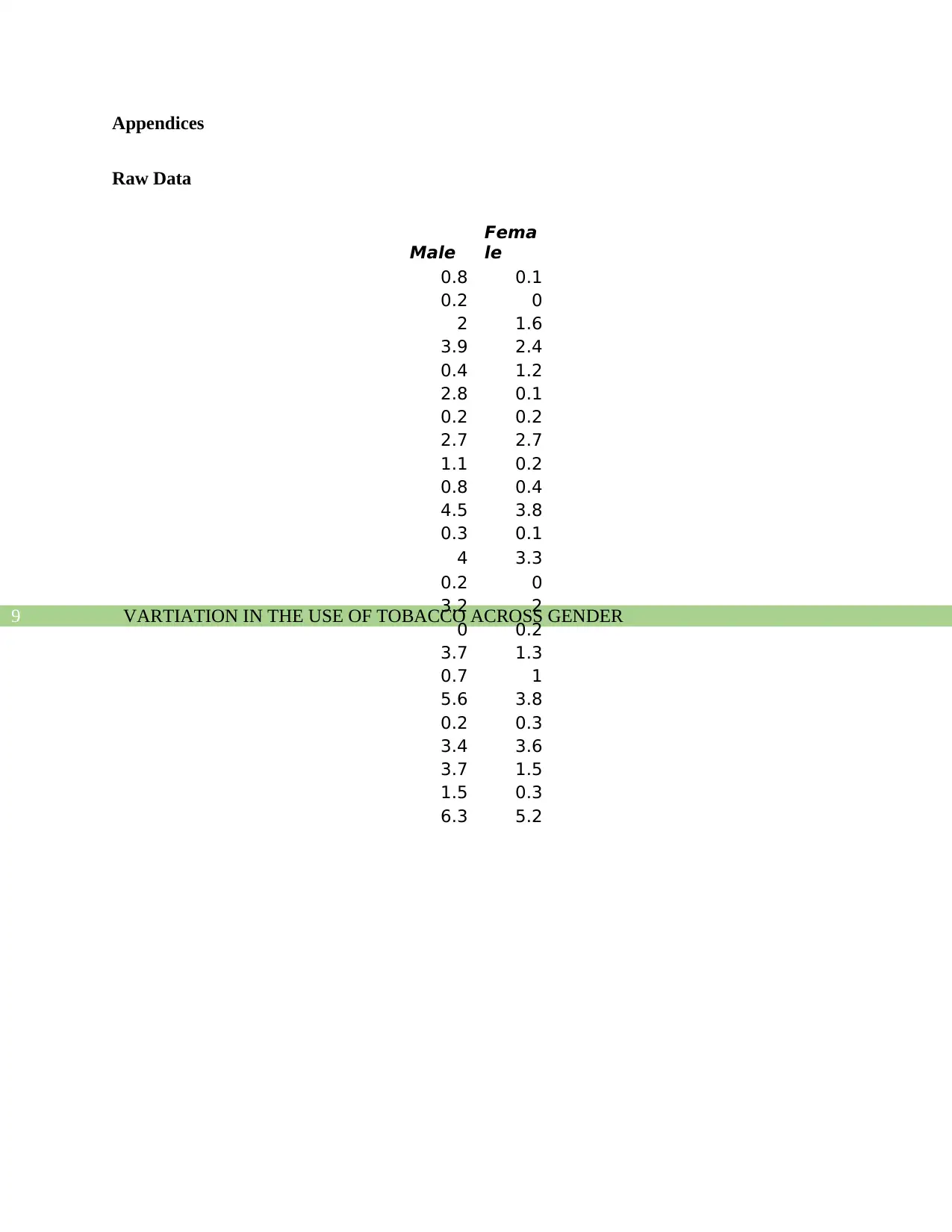
VARTIATION IN THE USE OF TOBACCO ACROSS GENDER9
Appendices
Raw Data
Male
Fema
le
0.8 0.1
0.2 0
2 1.6
3.9 2.4
0.4 1.2
2.8 0.1
0.2 0.2
2.7 2.7
1.1 0.2
0.8 0.4
4.5 3.8
0.3 0.1
4 3.3
0.2 0
3.2 2
0 0.2
3.7 1.3
0.7 1
5.6 3.8
0.2 0.3
3.4 3.6
3.7 1.5
1.5 0.3
6.3 5.2
Appendices
Raw Data
Male
Fema
le
0.8 0.1
0.2 0
2 1.6
3.9 2.4
0.4 1.2
2.8 0.1
0.2 0.2
2.7 2.7
1.1 0.2
0.8 0.4
4.5 3.8
0.3 0.1
4 3.3
0.2 0
3.2 2
0 0.2
3.7 1.3
0.7 1
5.6 3.8
0.2 0.3
3.4 3.6
3.7 1.5
1.5 0.3
6.3 5.2
Paraphrase This Document
Need a fresh take? Get an instant paraphrase of this document with our AI Paraphraser
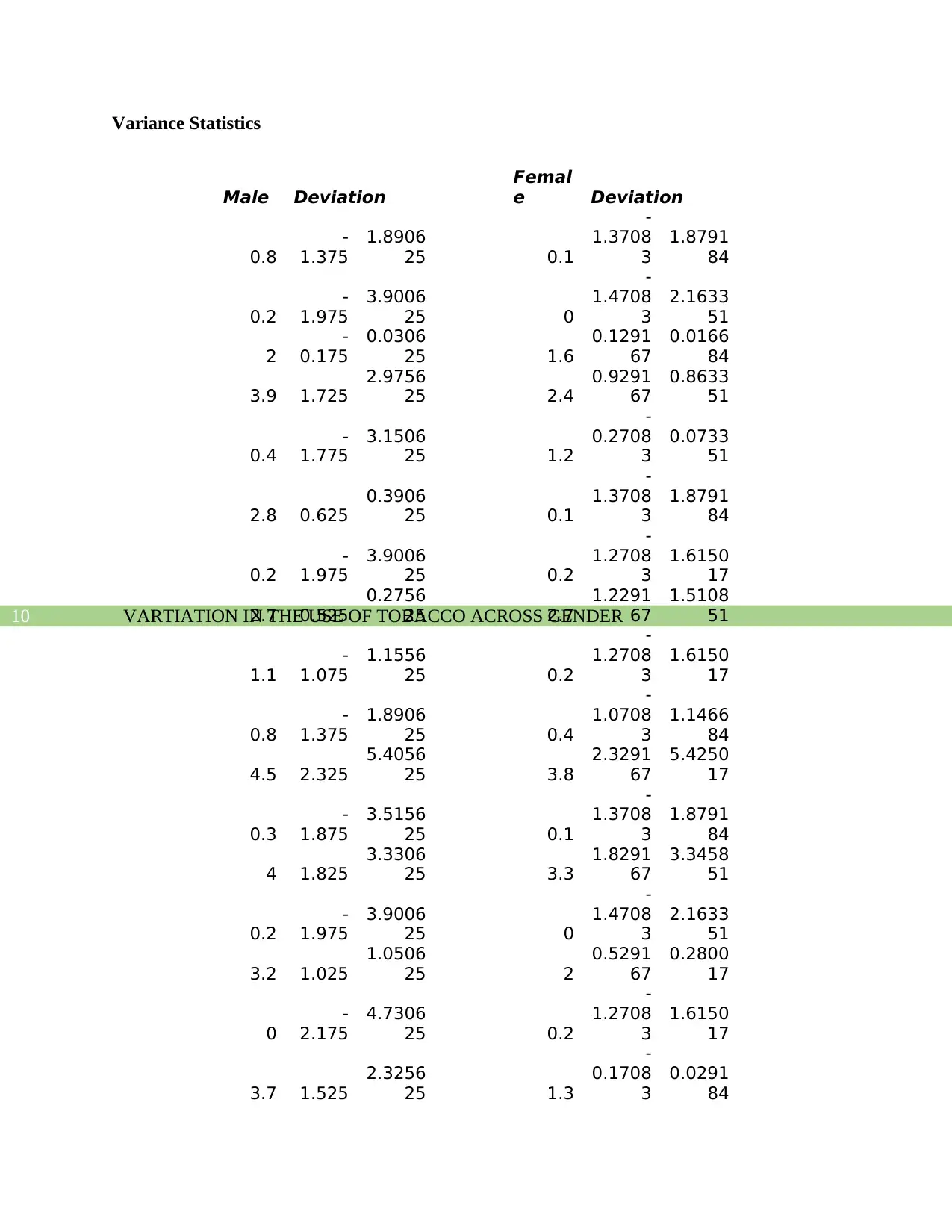
VARTIATION IN THE USE OF TOBACCO ACROSS GENDER10
Variance Statistics
Male Deviation
Femal
e Deviation
0.8
-
1.375
1.8906
25 0.1
-
1.3708
3
1.8791
84
0.2
-
1.975
3.9006
25 0
-
1.4708
3
2.1633
51
2
-
0.175
0.0306
25 1.6
0.1291
67
0.0166
84
3.9 1.725
2.9756
25 2.4
0.9291
67
0.8633
51
0.4
-
1.775
3.1506
25 1.2
-
0.2708
3
0.0733
51
2.8 0.625
0.3906
25 0.1
-
1.3708
3
1.8791
84
0.2
-
1.975
3.9006
25 0.2
-
1.2708
3
1.6150
17
2.7 0.525
0.2756
25 2.7
1.2291
67
1.5108
51
1.1
-
1.075
1.1556
25 0.2
-
1.2708
3
1.6150
17
0.8
-
1.375
1.8906
25 0.4
-
1.0708
3
1.1466
84
4.5 2.325
5.4056
25 3.8
2.3291
67
5.4250
17
0.3
-
1.875
3.5156
25 0.1
-
1.3708
3
1.8791
84
4 1.825
3.3306
25 3.3
1.8291
67
3.3458
51
0.2
-
1.975
3.9006
25 0
-
1.4708
3
2.1633
51
3.2 1.025
1.0506
25 2
0.5291
67
0.2800
17
0
-
2.175
4.7306
25 0.2
-
1.2708
3
1.6150
17
3.7 1.525
2.3256
25 1.3
-
0.1708
3
0.0291
84
Variance Statistics
Male Deviation
Femal
e Deviation
0.8
-
1.375
1.8906
25 0.1
-
1.3708
3
1.8791
84
0.2
-
1.975
3.9006
25 0
-
1.4708
3
2.1633
51
2
-
0.175
0.0306
25 1.6
0.1291
67
0.0166
84
3.9 1.725
2.9756
25 2.4
0.9291
67
0.8633
51
0.4
-
1.775
3.1506
25 1.2
-
0.2708
3
0.0733
51
2.8 0.625
0.3906
25 0.1
-
1.3708
3
1.8791
84
0.2
-
1.975
3.9006
25 0.2
-
1.2708
3
1.6150
17
2.7 0.525
0.2756
25 2.7
1.2291
67
1.5108
51
1.1
-
1.075
1.1556
25 0.2
-
1.2708
3
1.6150
17
0.8
-
1.375
1.8906
25 0.4
-
1.0708
3
1.1466
84
4.5 2.325
5.4056
25 3.8
2.3291
67
5.4250
17
0.3
-
1.875
3.5156
25 0.1
-
1.3708
3
1.8791
84
4 1.825
3.3306
25 3.3
1.8291
67
3.3458
51
0.2
-
1.975
3.9006
25 0
-
1.4708
3
2.1633
51
3.2 1.025
1.0506
25 2
0.5291
67
0.2800
17
0
-
2.175
4.7306
25 0.2
-
1.2708
3
1.6150
17
3.7 1.525
2.3256
25 1.3
-
0.1708
3
0.0291
84
1 out of 11
Related Documents
Your All-in-One AI-Powered Toolkit for Academic Success.
+13062052269
info@desklib.com
Available 24*7 on WhatsApp / Email
![[object Object]](/_next/static/media/star-bottom.7253800d.svg)
Unlock your academic potential
Copyright © 2020–2025 A2Z Services. All Rights Reserved. Developed and managed by ZUCOL.




